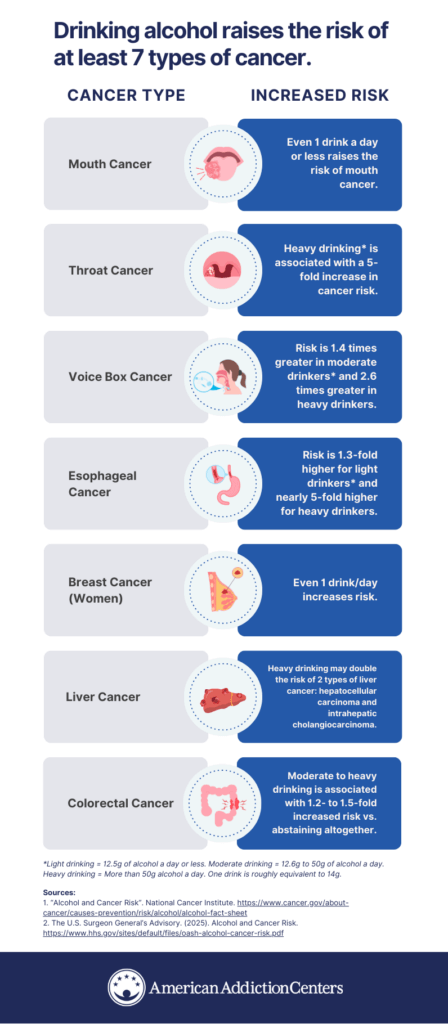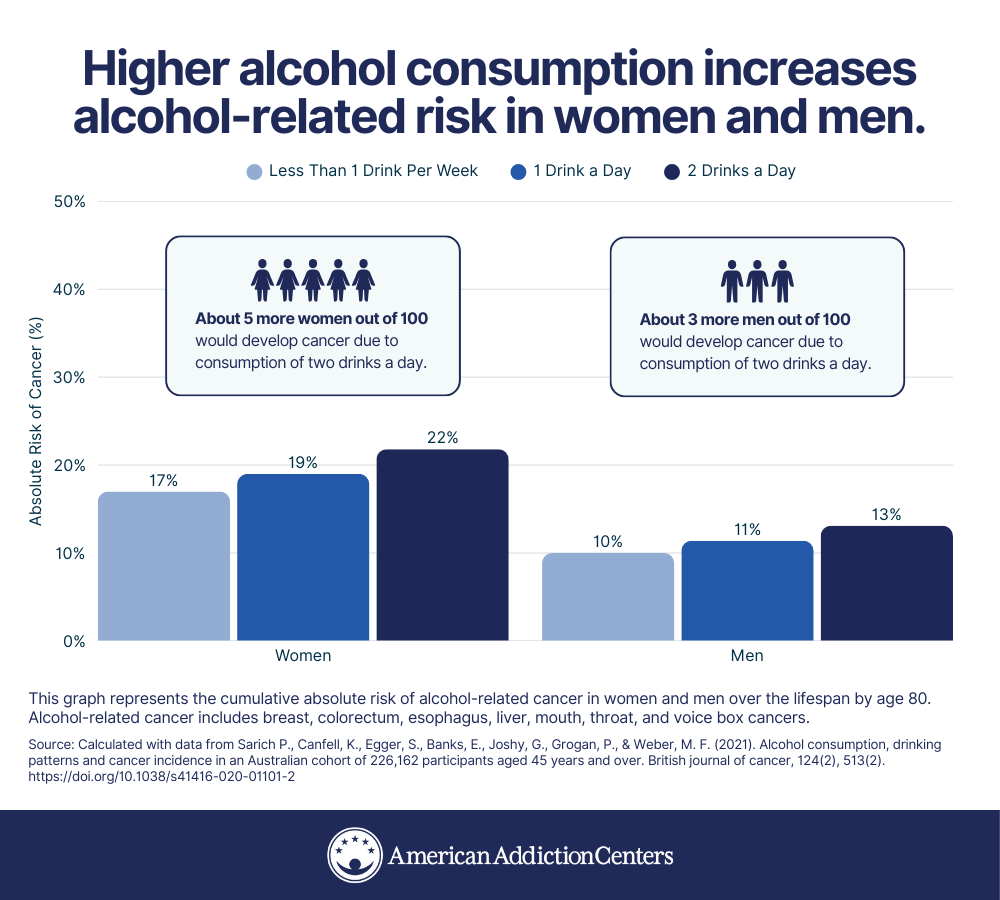The Science Behind The Link Between Alcohol and Cancer: What You Need to Know
Alcohol is considered the 3rd leading cause of cancer in the U.S., trailing tobacco use and obesity. While most Americans are aware alcohol has many unhealthy effects, its cancer risk is largely ignored.
The U.S. Surgeon General’s 2025 advisory Alcohol and Cancer Risk highlights the extent of the problem.
Alcohol: The Overlooked Cancer Risk
Alcohol use is widespread in the United States, with 72% of American adults consuming at least one alcoholic beverage a week, despite it causing 100,000 cancer cases in the United States each year.1
The majority of American adults still don’t know about the causal relationship between alcohol and cancer, despite the mounting evidence. While 91% of Americans surveyed in 2019 recognized radiation exposure as cancer-causing, only 45% knew about the link between alcohol and cancer.1 This means public awareness of alcohol use as a cancer risk factor has not significantly increased in nearly 2 decades.1
However, scientists and public health officials have known that alcohol and cancer are linked since the late 1980s. The International Agency for Research on Cancer (IARC) classifies alcohol as a “Group 1” carcinogen, meaning that “there is enough evidence to conclude that it can cause cancer in humans.” This claim is consistent with those made by other reputable health agencies like the World Cancer Research Fund/American Institute for Cancer Research (WCRF/AICR), the U.S. National Toxicology Program, the Centers for Disease Control and Prevention (CDC), and the National Institutes of Health’s National Cancer Institute (NCI).1
How Many Americans Are Increasing Their Cancer Risk with Alcohol?
You may be shocked to find out how little alcohol it takes to pose a cancer risk. Breast, mouth, and throat cancer risk is increased with just 1 drink a day. Approximately 185,100 cancer cases worldwide are attributed to drinking 2 or fewer alcoholic beverages a day, on average.
According to 2018 data compiled by the CDC:2
- 5.1% of American adults are considered heavy drinkers. This category includes men who consume 14 or more drinks a week and women who have 7 or more drinks a week.
- 15.5% are considered moderate drinkers. This includes men who consume 4-14 drinks a week and women who consume 4-7 drinks.
- 45.7% are light drinkers, consuming an average of 3 or less drinks a week.
This means many Americans are at serious risk, with potentially tragic consequences. An astounding 20,000 Americans die from alcohol-related cancer each year, surpassing the number of alcohol-involved traffic fatalities by a 32.5% margin.1
A Scientific Look: How Alcohol Can Cause Cancer
Not only has the link between alcohol and cancer been confirmed, scientists have been able to ascertain several paths by which alcohol contributes to cancer development. To date, researchers have identified 4 different ways alcohol use causes cancer:1
- Alcohol breaks down in the body, turning into the metabolite acetaldehyde. This metabolite binds to DNA, damaging cells that replicate quickly and form tumors.
- Reactive oxidative species (ROS) are another byproduct of alcohol being absorbed in the body. ROS molecules damage cells, DNA, and tissue, leading to cancer and other diseases.
- Hormone levels are also disrupted by alcohol use. Increased levels of certain hormones like estrogen contribute to breast cancer development.
- Alcohol use can amplify the carcinogenic properties of other sources. For example, tobacco smoke particles dissolve in alcohol, increasing the risk of throat and mouth cancers.
Researchers also hypothesize that alcohol can cause cancer in other ways, such as by depleting folic acid in the body.1
Which Cancers Are Linked to Alcohol?
Several different forms of cancer have been linked to alcohol use. Researchers have confirmed that alcohol use increases the risk of:1
- Breast cancer (in women). Up to 1 drink a day can increase women’s breast cancer risk by 10% compared to women who don’t drink.
- Liver cancer. Liver cancer accounts for around 33% of men’s alcohol-related cancer deaths. Heavy drinking* may double the risk of 2 types of liver cancer: hepatocellular carcinoma and intrahepatic cholangiocarcinoma.3
- Colorectal cancer. Colorectal cancer accounts for around 21% of men’s alcohol-related cancer deaths. Moderate* to heavy drinking is associated with 1.2- to 1.5-fold increased risk vs. abstaining altogether.3
- Esophageal cancer. The risk of esophageal cancer ranges from 1.3-fold higher for light drinking* to nearly 5-fold higher for heavy drinking when compared to non-drinkers.3
- Voice box (larynx) cancer. The risk of laryngeal cancer is 1.4 times greater in moderate drinkers and 2.6 times greater in heavy drinkers than non-drinkers.3
- Mouth cancer. Even 1 drink a day or less raises the risk of mouth cancer.
- Throat (pharynx) cancer. Moderate drinking is associated with a 1.8-fold increase in pharyngeal cancer and heavy drinking with a 5-fold increase compared to non-drinkers.3
Alcohol is also suspected to increase the risk of skin, prostate, stomach, and pancreatic cancer, though more research into the topic is necessary.
*In this study, light drinking = 12.5g of pure alcohol a day or less (the amount in just under one standard drink). Moderate drinking = 12.6g to 50g of alcohol a day (up to 3.6 drinks). Heavy drinking = More than 50g of alcohol a day. One drink is roughly equivalent to 14g.

The More You Drink, The Higher The Risk
While even a small amount of alcohol has been shown to increase the risk of cancer, the danger is exacerbated by drinking more. Of the 741,300 worldwide alcohol-related cancer cases that occurred in 2020:1
- 25% of cancer cases (185,100) were attributed to having 2 or less drinks a day.
- 28.6% (209,800) were attributed to consuming 2-4 daily drinks.
- 20.4% of cases (153,400) were people who drank 4-6 drinks a day.
- 26% (192,100) consumed 6 or more alcoholic beverages a day.
Note that considerably fewer people drink 6 or more drinks a day than 2 or less and yet the number of cancer cases in these populations are similar.
- 83% of alcohol-related cancer deaths occurred among Americans who drank 2 drinks or more daily.1
- 17% of alcohol-related cancer deaths occurred among Americans who drank less than 2 drinks a day.1
A strong potential predictor of alcohol-related cancer is the amount someone drinks over an extended period. However, research has yet to identify the cancer risk of other drinking patterns.
For example, binge drinking—defined as 5 drinks in one occasion for men and 4 drinks for women—is prevalent in the U.S. and is associated with several dangerous health effects. While research has yet to delineate the impact of binge drinking vs. non-binge drinking on someone’s cancer risk, studies have connected binge drinking to increases in acetaldehyde exposure. More research is needed on the carcinogenic effect of drinking at specific age ranges (e.g., adolescence, middle age, late adulthood).1
Is a Glass of Wine a Day Good For You?
Some claim that drinking a glass of wine daily is healthy, citing the presence of antioxidants—specifically resveratrol—as evidence of its benefits. However, the evidence behind its health benefits is largely unconfirmed, unlike the evidence of cancer risk incurred by drinking every day.4
Regardless of whether the antioxidants in wine are healthy, there are multiple other sources of antioxidants like fruits, vegetables, nuts, seeds, and herbs that don’t contain cancer-causing ingredients. Other sources of resveratrol include red grapes, grape juice, and numerous supplements.4
Are Women At a Higher Risk of Alcohol-Related Cancer?
Women already have a higher risk of developing cancer in general, and unfortuantely alcohol use increases cancer risk more for women than it does for men;1 2 drinks a day for women increases their cancer risk by 5.3% (from 16.5% to 21.8%) versus 3.1% for men (10% to 13.1%).1
A substantial part of this higher relative risk comparing women to men is the increased likelihood of developing breast cancer, which rises 1.8% in women who consume 2 drinks a day (from 11.3% to 13.1%). The majority of alcohol-related cancer deaths in women (about 60%) are due to breast cancer.1
Alcohol puts women at greater risk of cancer and other types of harm for several reasons:
- Women, on average, weigh less than men.5
- Women usually carry less water in their bodies than men, meaning that their blood-alcohol concentration (BAC) after drinks is higher.5
- Women typically produce less of the alcohol dehydrogenase (ADH) enzyme, which controls the rate at which alcohol is broken down in the body, further elevating their BAC and slowing the rate at which it declines.6
While cancer risk is greater for women who drink than their male counterparts, men are more likely to drink in general, more consistently, and in larger amounts.7

Moving Forward: Changing Attitudes Toward Alcohol
The sobering reality is that the amount of alcohol someone can safely drink is much less than most believe. Fortunately, there is some encouraging news as well.
For one, young people are drinking less than previous generations. According to a recent Gallup poll, the percentage of Americans 18-34 who say they drink at all dropped 10% over the past 2 decades.8 Encouraging trends like “sober curiosity” and a shift toward alcohol-free drinks are gaining traction; there is a significant chance we may see reduced alcohol-related cancer cases in the future as a result.
In addition, some studies have found that quitting or reducing drinking lowers cancer risk. For example, a recent review conducted by IARC found that quitting or reducing alcohol use decreased the risk of mouth and esophageal cancer.1 And while many people find it difficult to quit drinking, recovery from alcohol addiction is possible through evidence-based treatment.9
Of course, there is still much work to do. The Surgeon General’s report outlines several steps to face the problem, such as increasing public awareness about the cancer risk of alcohol use, increasing access to alcohol screening and entry into treatment in clinical or emergency settings, updating the recommended limits of alcohol use in light of new evidence, and more.1
